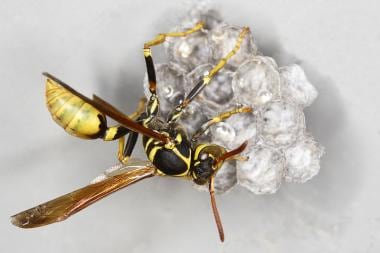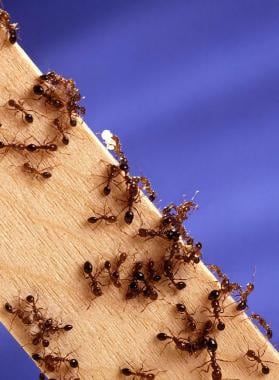Background
Hymenoptera stings account for more deaths in the United States than any other envenomation. The order Hymenoptera includes Apis species, ie, bees (European, African), vespids (wasps, yellow jackets, hornets), and ants (see the images below). Most deaths result from immediate hypersensitivity reactions and anaphylaxis. Severe anaphylactoid reactions occur occasionally when toxins directly stimulate mast cells. In addition to immunologic mechanisms, some injury occurs from direct toxicity. While the vast majority of stings cause only minor problems, stings cause a significant number of deaths.
 Western paper wasp (Mischocyttarus flavitarsis) building a nest. By Sanjay Acharya (self-made at Sunnyvale, California, USA). Courtesy of Wikimedia Commons.
Western paper wasp (Mischocyttarus flavitarsis) building a nest. By Sanjay Acharya (self-made at Sunnyvale, California, USA). Courtesy of Wikimedia Commons.
See Arthropod Envenomation: From Benign Bites to Serious Stings, a Critical Images slideshow, for help identifying and treating various envenomations. See also All About Allergies: Be Ready for Spring, to help identify a variety of allergens and symptoms.
Pathophysiology
Target organs are the skin, vascular system, and respiratory system. Pathology is similar to other immunoglobulin E (IgE)–mediated allergic reactions. Anaphylaxis is a common and life-threatening consequence of Hymenoptera stings and is typically a result of sudden systemic release of mast cells and basophil mediators. [1] Urticaria, vasodilation, bronchospasm, laryngospasm, and angioedema are prominent symptoms of the reaction. Respiratory arrest may result in refractory cases.
Etiology
Hymenoptera are social creatures that typically sting to protect their colony, nest, or hive. Most stings are incited by proximity to the colony. Noisy or vigorous activity (eg, lawn mowers, weed eaters), bright or dark colors, and perfumes also may incite stings. When a colony is disturbed, many Hymenoptera release defense pheromones that attract other members of the colony to sting. These pheromones are released during stinging or when an insect is smashed.
Although bee and wasp venom varies from species to species, all venom is composed primarily of proteins, peptides, and amines. Toxic components include phospholipase, histamine, bradykinin, acetylcholine, dopamine, and serotonin. In addition, mast cell degranulating (MCD) peptide and mastoparan are peptides that can cause degranulation of mast cells and result in an anaphylactoid reaction. Molecule size and the presence of protein enhance the antigen properties of venom, making it a potent activator of the immune system. Most significant reactions are mediated through true IgE allergic mechanisms that activate mast cell degranulation.
Anaphylactoid reactions may occur. However, venom load may be sufficient to cause fatal injury without the added effects of the endogenous system. This may result from as few as 30 vespid stings or 200 honeybee stings. Since the compounds are similar in anaphylactic and toxic reactions, pathology and treatment also are similar.
Bees and wasps sting through a modified ovipositor. They puncture the skin with a hollow stinger and then inject venom. Bees leave their barbed stinger in the skin along with its stinging apparatus, killing the bee. Vespids have smooth or less-barbed stingers and can sting more than once. Vespids are responsible for almost twice as many allergic reactions as honeybees. Retained stingers can cause granuloma formation and subsequent epidermal necrosis.
"Killer" bee is the moniker applied to the Africanized honeybee (Apis mellifera scutellata), which was originally introduced into the New World as a hybrid of European honeybees and a variety of honeybee from Africa. Toxicity from the sting of a single Africanized bee is no worse than the sting of a single European bee. Africanized honeybees show behavioral changes, including increased defensive stinging. One pheromone, isoamylacetate, has been isolated as a mediator of aggressive group-defensive behaviors in Africanized bees. Africanized bees defend their hive up to a 150-yard radius, three times the distance of European bees. As of May 2000, Africanized bees have migrated from their western-hemisphere origin in Brazil to Texas, Arizona, California, New Mexico, Nevada, Utah, Alabama, Louisiana, Arkansas, Oklahoma, and Florida, according to the US Department of Agriculture. [2] Multiple stings from these species are more common. Honeybees fly at only 4 mph, allowing most victims to flee after only a few stings. Overwhelming numbers of stings usually occur in young patients or in those slowed by physical limitations or intoxication.
In addition to reaction to stings, bee venom may be encountered as a result of apiotherapy, a modality used in traditional Chinese medicine. In this treatment, ointment containing bee venom is applied to skin or eye and may result in an immunologic reaction.
Ant stings
Ants account for one half of all insects. While many ant species sting, the most aggressive in the United States are imported fire ants, Solenopsis invicta. These ants fiercely guard their territory and attack intruders in large numbers, inflicting thousands of stings and bites to victims unable to escape. Fire ant venom is 95% alkaloid, which is unique among ants. A fire ant typically bites with its mandibles, then swivels its abdomen and stings repeatedly in an arc about the bite site. Their stings develop into sterile pustules and then rupture, leaving crusted wounds that may become infected secondarily. Patients have survived as many as 5000 fire ant stings. Brazilian fire ants, S invicta, have nearly eradicated native ant species in their range from Florida to Texas and north to Arkansas and South Carolina. S invicta is found in South and North America in areas where mean high temperatures are 15°C or higher.
Stings from other ants often closely resemble those of wasps and bees, although with less tissue destruction and less severity. Harvester ants, Pogonomyrmex species, inject venom containing a hemolysin. This sting frequently creates an ecchymotic area surrounding the sting site. Some species of field ants truly bite with the mandible and spray the acidic toxin into the wound without injecting venom. Formic acid, a component of ant venom uncommon in bee or wasp stings, is derived from the superfamily name Formicidae. Ant stings cause generalized reactions less often than stings from flying Hymenoptera.
Epidemiology
Frequency
United States
Ants sting 9.3 million people each year. Other Hymenoptera species account for more than 1 million stings annually. Anaphylaxis secondary to Hymenoptera envenomation affects roughly 3% of the general population. [3] Systemic reactions leading to life-threatening manifestations occurs in approximately 0.4-0.8% of children and 3% of adult patients. [4]
According the US Bureau of Labor Statistics, from 2003 to 2010, bees accounted for 52 fatal occupational injuries, wasps/yellow jackets 14, and ants 4 [5] . Additionally, fatal occupational injuries involving insects, by year, are as follows [5] :
-
2003: 6 deaths
-
2004: 10 deaths
-
2005: 15 deaths
-
2006: 10 deaths
-
2007: 11 deaths
-
2008: 10 deaths
-
2009: 9 deaths
-
2010: 12 deaths
The 2019 Annual Report of the American Association of Poison Control Centers' National Poison Data System reported 592 single exposures of ant or fire ant bites, with 31 moderate and 3 major outcomes and 0 deaths. [6] It also reported 2,537 single exposures of bee, wasp, or hornet stings, with 196 moderate and 9 major outcomes and 1 death. However, because of underreporting, this is probably an underestimation of the true number of stings.
International
A 2009 study from Costa Rica reported on Hymenoptera sting fatalities over a 22-year period (1985-2006). The annual number of deaths varied from 0-6 (2.4 deaths/year average), with a total of 52 deaths over the study period. Most deaths were in older (>50 years) and younger (< 10 years) males. [7]
From 1979 through 1998, 7 fatalities from wasp stings were reported in Australia, all from rural areas; 5 of the 7 had a history of wasp or bee venom allergy. [8]
Race
No race predilection exists.
Sex
Hymenoptera stings of all types are more common in males than in females, probably because of more frequent exposure.
Age
Although most deaths from toxic reactions occur at extremes of age, frequency of bites is not age dependent. Peak incidence of death from anaphylaxis is in people aged 35-45 years.
Prognosis
Most stings resolve with no residual complaints. Large local reactions do not predispose patients to generalized reactions in the future. Less severe generalized reactions precede most fatal reactions.
Large local reactions occur in 17-56% of those stung. In one study, 1-2% experienced a generalized reaction, and 5% sought medical care. Individuals with large local reactions have a 5-10% risk of subsequent development of a severe systemic reaction if re-stung. [4]
An updated review of animal-related deaths in 2005 determined that Hymenoptera stings accounted for 533 deaths in the United States from 1991-2001. This number represented 70.2% of all venomous animal-related fatalities in the United States during this period. [9]
In 1989, 32 deaths were reported from fire ant stings in Texas, Florida, Louisiana, and Georgia. [10]
Wasps and bees cause 30-120 deaths yearly in the United States.
Patient Education
Educate all patients on how to avoid stings.
For patient education resources, see the Bee and Wasp Stings Center, Environmental Exposures and Injuries Center, Allergy Center, and Allergic Reaction and Anaphylactic Shock Center, as well as Bee and Wasp Stings and Severe Allergic Reaction (Anaphylactic Shock).
For related information, see Medscape's Allergy Resource Center.
-
Western paper wasp (Mischocyttarus flavitarsis) building a nest. By Sanjay Acharya (self-made at Sunnyvale, California, USA). Courtesy of Wikimedia Commons.
-
Yellow jacket. By Richard Bartz, Munich aka Makro Freak (Own work). Courtesy of Wikimedia Commons.
-
Fire ant bites. In less than 10 seconds, an unwary scientist was stung over 250 times on one leg when he carelessly knelt on a collapsed fire ant mound. The sterile pustules developed to this stage in 3 days. US Department of Agriculture. Courtesy of Wikimedia Commons.
-
Fire ants. US Department of Agriculture. Courtesy of Wikimedia Commons.











